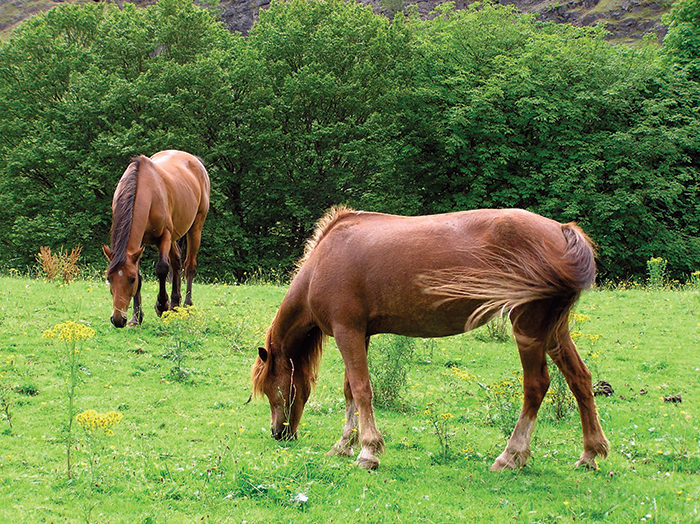By Susan Pratt-Phillips, PhD
The reason the risk of laminitis increases in the spring is that as the days get longer, the extra sunlight increases photosynthesis, which results in starch, sugar and, in some plants, fructan production. We also tend to have cooler temperatures at night, which prevents the plants from using these sugars, and they accumulate.
Fructans are poorly digested within the horse’s small intestine, so they pass through to the large intestine, as do sugars when consumed in large amounts. When these reach the large intestine, the microbial organisms residing there ferment these new substrates rapidly, resulting in a shift toward the production of lactic acid and compounds called vasoactive amines (substances containing amino groups), as well as a drop in pH.
Changes in pH alter the permeability of the intestinal lining, which is believed to allow the absorption of the vasoactive amines and potential other toxins, and can contribute towards laminaellar separation.
Elevated insulin concentrations also have been shown to trigger laminitis, and horses that are consuming “sugary” pasture or that are already insulin resistant (and have high resting insulin concentrations) may have their insulin concentrations reach critical levels. So, prevention of laminitis is two-fold: limit pasture intake, particularly when sugar content is expected to be high and prevent/manage insulin resistance.
The only way to truly know the sugar content of your pasture is to have it tested; however, sugar (glucose and fructan) content can fluctuate throughout the day, and over several days, weeks and months. Despite this, it is recommended to have your pasture tested at least once per year, to get a baseline idea of sugar content. Ideally, you would have your pasture sampled closer to four or more times per year, to get an idea of fluctuation across the seasons.
Introduction to spring grass depends a bit on your general pasture management. If your horses are out in a big field all winter, they will likely adapt to the newly sprouting grass gradually. Horses that do not typically have access to pasture should be introduced slowly – starting with 30 minutes to one hour per day and increasing slowly, to give time for the microbial organisms to adapt. Regardless of adaptation, it is possible for the pasture, and sugars within it, to have higher sugar and/or fructan content than a horse can handle. Therefore, horses may have to be limited in turnout at certain times of the year.
In the spring and fall, we often have nice sunny days, but with cooler nights. These low overnight temperatures lend themselves to sugar accumulation, and horses grazing following a frost may be at risk. Similarly, on sunny days, sugars accumulate during the day and peak in the late afternoon/early evening. Therefore, horses may need to be restricted from pasture at these times.
So, how can you restrict pasture? Ideally, horse farms have a sacrifice area or dry lot that can be used to house horses at times when pasture is not ideal for consumption. Alternatively, horses may need to remain in a stall. Then, horses can be turned out at pasture for specific periods of time, again potentially avoiding the hazardous late afternoon grass. It has been documented, however, that once horses know a schedule in terms of their time at pasture, their pasture intake rate can actually increase. For example, horses outside at pasture for only 8 hours can consume all of their digestible energy intake from pasture in that limited time. Ponies are even worse culprits, achieving dangerously high intake rates when pasture access is restricted. Of course, this type of behavior is variable between horses, but should be considered. When horses are at pasture, grazing muzzles can significantly decrease intake for most horses. Some horses do not “get” muzzles and cannot eat at all, while others can figure out how to still consume relatively large amounts of pasture. Keen observation is important.
Good pasture management can also decrease the risk of pasture associated laminitis. Keeping grasses in their growing stage by mowing regularly can help force the plants to continuously use sugars and not accumulate them. Also, using pasture rotation and giving horses adequate pasture quantity (by acreage per horse) can help horses more effectively graze pasture. Working with your local horse specialist can help you identify ideal grazing methods for your facilities.
Dealing with spring pasture may be time-consuming and stressful for both you and your (muzzled) horse, but consider that laminitis is a far worse fate.







